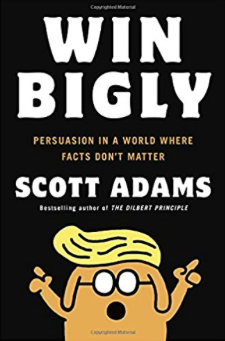I recently read “Win Bigly: Persuasion In A World Where Facts Don’t Matter” by Scott Adams. Below are the quotes I found most interesting. If you like the quotes, click here to buy the book.
 “We all think we are the enlightened ones. And we assume the people who disagree with us just need better facts, and perhaps better brains, in order to agree with us. That filter on life makes most of us happy – because we see ourselves as the smart ones.” (3)
“We all think we are the enlightened ones. And we assume the people who disagree with us just need better facts, and perhaps better brains, in order to agree with us. That filter on life makes most of us happy – because we see ourselves as the smart ones.” (3)
“The method goes like this:
Make a claim that is directionally accurate but has a big exaggeration or factual error in it.
Wait for people to notice the exaggeration or error and spend endless hours talking about how wrong it is.
When you dedicate focus and energy to an idea, you remember it. And the things that have the most mental impact on you will irrationally seem as though tye are high in priority, even if they are not. That’s persuasion.” (20)
“The things that you think about the most will irrationally rise in importance in your mind.” (22)
“Consider a small 2012 study by researcher Daniel Oppenheimer that found students had better recall when a font was harder to read.” (25)
“A good general rule is that people are more influenced by visual persuasion, emotion, repetition, and simplicity than they are by details and facts.” (25)
“Humans think they are rational, and they think they understand their reality. But they are wrong on both counts.” (35)
“The main theme of this book is that humans are not rational. We bounce from one illusion to another, all the while thinking we are seeing something we call reality. The truth ist hat facts and reason don’t have much influence on our decisions, except for trivial things, such as putting gas in your car when you are running low. On all the important stuff, we are emotional creatures who make decisions first and rationalize them after the fact.” (37)
“On mushrooms… your perceptions are independent from the underlying reality. This awareness never leaves you. Once you understand your experience of life as an interpretation of reality, you can’t go back to your old way of thinking.” (43)
“The most common trigger for cognitive dissonance is when a person’s self-image doesn’t fit their observations. For example, if you believe you are a smart and well-informed person, and then
You do something that’s clearly dumb, it sends you into a state of cognitive dissonance. And once you are in that uncomfortable state of mind, your brain automatically generates an illusion to solve the discomfort. In this situation, your brain would tell you the new information was inaccurate. The alternative is to believe that you are dumb, and that violates your self-image. You don’t like to change your self-image unless it is in the direction of improvement.” (49)
“It is easy to fit completely different explanations to the observed facts. Don’t trust any interpretation of reality that isn’t able to predict.” (54)
“People are more influenced by the direction of things than the current state of things.” (68)
“The reality one learns while practicing hypnosis is that we make our decisions first – for irrational reasons – and we rationalize them later as having something to do with facts and reason.” (71)
“If you want the audience to embrace your content, leave out any detail that is both unimportant and would give people a reason to think, That’s not me. Design into your content enough blank spaces so people can fill them in with whatever makes them happiest.” (78)
“Our brains interpret high energy as competence and leadership (even when it isn’t).” (92)
“Our visual sense is the most persuasive of our fives senses, so using a real person whom we recognize, and can imagine, is a great technique.” (95)
“Below I rank for you the broad forms of persuasion by their relative power…
Big fear
Identity
Smaller fear
Aspirations
Habit
Analogies
Rason
Hypocrisy
Word-thinking” (99)
“When you attack a person’s belief, the person under attack is more likely to harden his belief than to abandon it, even if your argument is airtight.” (106)
“Fear can be deeply persuasive. But not all fear-related persuasion is equal. To maximize your fear persuasion, follow these guidelines.
A big fear is more persuasive than a small one.
A personal fear is more persuasive than a generic national problem.
A fear that you think about most often is stronger than one you rarely think about.
A fear with a visual component is scarier than one without.
A fear you have experienced firsthand (such as a crime) is scarier than a statistic.” (114)
“It is easier to persuade people when they expect to be persuaded. If your persuasion skills are viewed as credible, people will persuade themselves that you can persuade them, and that makes everything easier.Credibility, of any sort, is persuasive.” (116)
“If you want to persuade use visual language and visual imagery. The difference in effectiveness is enormous.” (137)
“Participate in activities at which you excel compared with others. People’s impression of you as talented and capable compared with the average participant will spill over to the rest of your personal brand.” (147)
“In business, always present your ideas in the context of alternatives that are clearly worse. Don’t just sell your proposed solution; slime all the other options with badness.” (147)
“Always remember that people make decisions in the context of alternatives. If you aren’t framing the alternatives as bad, you are not persuading at all.” (147)
“When you associate any two ideas or images, people’s emotional reaction to them will start to merge over time.” (153)
“Humans put more importance on the first part of a sentence than the second part.” (159)
“Simplicity makes your ideas easy to understand, easy to remember, and easy to spread. You can be persuasive only when you are also memorable.” (201)
Liked the quotes? Click here to buy the book.

